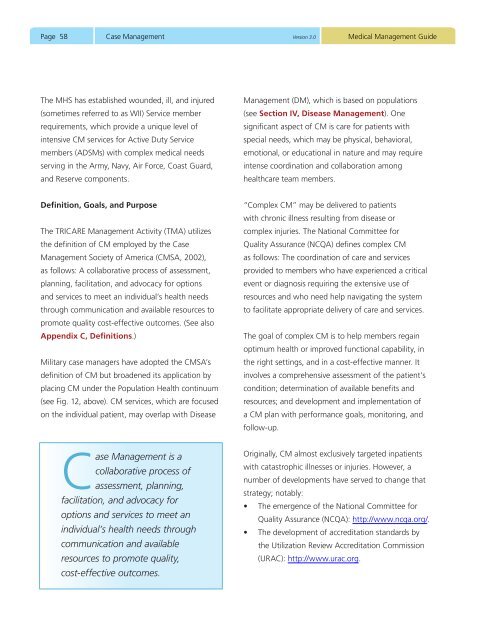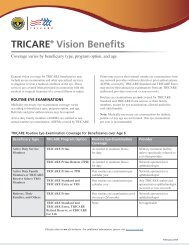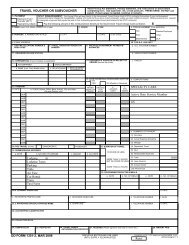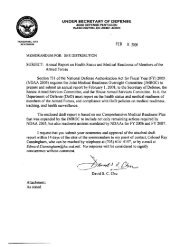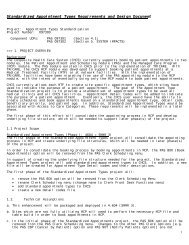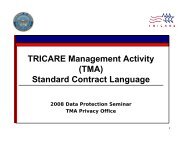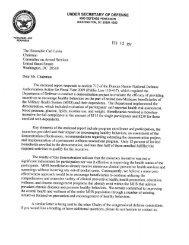Medical Management Guide, 2009, Version 3.0 - Tricare
Medical Management Guide, 2009, Version 3.0 - Tricare
Medical Management Guide, 2009, Version 3.0 - Tricare
- No tags were found...
Create successful ePaper yourself
Turn your PDF publications into a flip-book with our unique Google optimized e-Paper software.
Page 58Case <strong>Management</strong> <strong>Version</strong> <strong>3.0</strong><strong>Medical</strong> <strong>Management</strong> <strong>Guide</strong>The MHS has established wounded, ill, and injured(sometimes referred to as WII) Service memberrequirements, which provide a unique level ofintensive CM services for Active Duty Servicemembers (ADSMs) with complex medical needsserving in the Army, Navy, Air Force, Coast Guard,and Reserve components.<strong>Management</strong> (DM), which is based on populations(see Section IV, Disease <strong>Management</strong>). Onesignificant aspect of CM is care for patients withspecial needs, which may be physical, behavioral,emotional, or educational in nature and may requireintense coordination and collaboration amonghealthcare team members.Definition, Goals, and PurposeThe TRICARE <strong>Management</strong> Activity (TMA) utilizesthe definition of CM employed by the Case<strong>Management</strong> Society of America (CMSA, 2002),as follows: A collaborative process of assessment,planning, facilitation, and advocacy for optionsand services to meet an individual’s health needsthrough communication and available resources topromote quality cost-effective outcomes. (See alsoAppendix C, Definitions.)Military case managers have adopted the CMSA’sdefinition of CM but broadened its application byplacing CM under the Population Health continuum(see Fig. 12, above). CM services, which are focusedon the individual patient, may overlap with Disease“Complex CM” may be delivered to patientswith chronic illness resulting from disease orcomplex injuries. The National Committee forQuality Assurance (NCQA) defines complex CMas follows: The coordination of care and servicesprovided to members who have experienced a criticalevent or diagnosis requiring the extensive use ofresources and who need help navigating the systemto facilitate appropriate delivery of care and services.The goal of complex CM is to help members regainoptimum health or improved functional capability, inthe right settings, and in a cost-effective manner. Itinvolves a comprehensive assessment of the patient’scondition; determination of available benefits andresources; and development and implementation ofa CM plan with performance goals, monitoring, andfollow-up.Case <strong>Management</strong> is acollaborative process ofassessment, planning,facilitation, and advocacy foroptions and services to meet anindividual’s health needs throughcommunication and availableresources to promote quality,cost-effective outcomes.Originally, CM almost exclusively targeted inpatientswith catastrophic illnesses or injuries. However, anumber of developments have served to change thatstrategy; notably:• The emergence of the National Committee forQuality Assurance (NCQA): http://www.ncqa.org/.• The development of accreditation standards bythe Utilization Review Accreditation Commission(URAC): http://www.urac.org.


